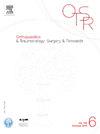负重时外翻高胫骨截骨的骨板和外侧铰链上的载荷分布分析:有限元分析。
IF 2.3
3区 医学
Q2 ORTHOPEDICS
引用次数: 0
摘要
简介:胫骨内翻高位截骨术(HTO)适用于治疗胫骨近端骺端畸形的年轻患者的孤立性膝关节内侧骨关节炎。在内侧开放 HTO 中,保持外侧铰链的完整性对于确保正常愈合和矫正保持至关重要。使用锁定钢板来稳定 HTO 是常见的做法,这样可以让患者更早地负重。因此,本研究的目的是使用有限元(FE)模型模拟单腿站立负荷,测量并跟踪锁定固定钢板和 HTO 外侧铰链的机械负荷分布:假设:工作假设是在负重期间,固定板和外侧铰链不对称地吸收应力,主要是固定板吸收应力:根据健康胫骨近端实际的几何形状(使用 Autodesk Fusion 360 和 Altair HyperWorks 软件),建立了使用锁定钢板稳定 HTO 的数值模型。在对加载进行有限元模拟时,进行了网格收敛研究,以优化数值模型结果的准确性。主要结果指标是钢板和横向铰链受影响区域的最大应力值(Von Mises 应力,单位 MPa):结果:钢板的最大应力强度约为 20.29 兆帕。骨铰链的最大应力强度约为 5.6 兆帕。铰链和钢板的网格收敛性研究结果为今后的 FE 研究确定了最合适的模型:除钢板和铰链的高应力区域外,所有模型元素的网格尺寸均为 4 毫米,而钢板和铰链的网格尺寸为 0.7 毫米。这种调整为研究提供了更高的精度:板和铰链上都存在应力分布和分配,这突出了板的重要性和保留铰链的绝对必要性。可以预见的是,钢板吸收了大部分负荷,是铰链的三倍多:结论:假设得到了证实;然而,要验证这些数值结果,还需要进行更多的研究:在装有仪器的尸体骨骼上进行实验,并对不同的固定板进行比较研究:V级,专家意见;实验室对照研究。本文章由计算机程序翻译,如有差异,请以英文原文为准。
Analysis of load distribution on the plate and lateral hinge of a valgus opening high tibial osteotomy during weight-bearing: a finite element analysis
Introduction
Valgus high tibial osteotomy (HTO) is indicated for managing isolated medial knee osteoarthritis in a young patient with a metaphyseal deformity of the proximal tibia. In a medial opening HTO, maintaining the integrity of the lateral hinge is crucial for ensuring proper healing and correction retention. Using a locked plate to stabilize an HTO is common practice, allowing for earlier weight-bearing. The objective of this study was therefore to measure and track the mechanical load distribution on a locked fixation plate and the lateral hinge of an HTO using a finite element (FE) model simulating single-leg stance loading.
Hypothesis
The working hypothesis was that during weight-bearing, the plate and the lateral hinge absorb stress asymmetrically, predominantly on the plate.
Material and methods
A numerical model of an HTO stabilized with a locked plate was developed based on the actual geometry of a healthy proximal tibia (using Autodesk Fusion 360 and Altair HyperWorks software). In this finite element simulation of loading, a mesh convergence study was conducted to optimize the accuracy of the numerical model results. The primary outcome measure was the maximum stress value in the affected areas (Von Mises stress, in MPa) of the plate and the lateral hinge.
Results
The maximum stress intensity in the plate was approximately 20.29 MPa. The maximum stress intensity in the bony hinge was about 5.6 MPa. The results of the mesh convergence study for the hinge and the plate enabled defining the most suitable model for future FE studies: a 4 mm mesh for all model elements except for the high-stress area in the plate and the hinge, which were meshed with a 0.7 mm element size. This adaptation provided greater precision in the study.
Discussion
There is a distribution and allocation of stress both on the plate and the hinge, underlining the significance of the plate and the absolute necessity of preserving the hinge. Predictably, the plate absorbs the majority of the load, more than three times that of the hinge.
Conclusion
The hypothesis is confirmed; however, additional studies would be necessary to validate these numerical results: an experimental component on instrumented cadaveric bones, as well as comparative studies of different fixation plates.
Level of Evidence
V, expert opinion; controlled laboratory study.
求助全文
通过发布文献求助,成功后即可免费获取论文全文。
去求助
来源期刊
CiteScore
5.10
自引率
26.10%
发文量
329
审稿时长
12.5 weeks
期刊介绍:
Orthopaedics & Traumatology: Surgery & Research (OTSR) publishes original scientific work in English related to all domains of orthopaedics. Original articles, Reviews, Technical notes and Concise follow-up of a former OTSR study are published in English in electronic form only and indexed in the main international databases.

 求助内容:
求助内容: 应助结果提醒方式:
应助结果提醒方式:


